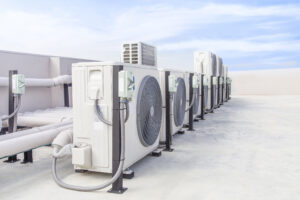
Do you recall the days when it was necessary to fumble with your thermostat’s controls when opening your store or restaurant in the morning? The HVAC industry has undergone a remarkable transformation since then, all thanks to the integration of Internet of Things (IoT) technology. Those traditional, standalone HVAC systems have given way to smart, connected, and intelligent climate control solutions, resulting in significant improvements in energy efficiency, cost savings, and overall occupant comfort.
Understanding IoT
IoT, or the Internet of Things, refers to the interconnectivity of everyday objects through the Internet, allowing them to communicate with each other and function in a more intelligent manner. This technology enables us to harness data from devices and use that information to make informed decisions, leading to enhanced energy efficiency, convenience, and overall performance. In the HVAC domain, this translates into smart thermostats, temperature sensors, and remote sensing technologies that work together to optimize the comfort and energy consumption of heating, ventilation, and air conditioning systems.
Challenges of Traditional HVAC Systems and the Need for IoT-Enabled Solutions
Traditional non-IoT HVAC systems require manual adjustments to set the temperature and control the system. The thermostat is connected to the HVAC system and signals it to turn on or off based on the set temperature. The system operates independently of other building systems, and there is limited feedback on its performance.
One of the most significant benefits of incorporating IoT into HVAC systems is how it can help buildings use less energy. Non-IoT-enabled HVAC systems are less efficient than their IoT counterparts, as they lack the advanced sensors, algorithms, and real-time monitoring that make IoT-enabled HVAC systems so effective at optimizing energy usage. Without these advanced features, non-IoT HVAC systems consume more energy, leading to higher energy bills and more significant carbon emissions.
Maintenance is another challenge with non-IoT-enabled HVAC systems. These systems require regular inspections and repairs to maintain their performance and prevent breakdowns. Unfortunately, without real-time monitoring or predictive maintenance capabilities, identifying potential issues with these systems can be difficult, leading to increased repair costs and downtime.
From Simple Thermostats to Smart Controls
In the past, HVAC systems relied on basic thermostats that required manual adjustments while modern systems are equipped with an array of IoT-enabled sensors providing invaluable data to onsite equipment for remote or even automated adjustments. This advanced level of control provides a level of efficiency and energy management that was previously unimaginable.
Another major advantage of IoT in HVAC is the increased level of convenience afforded to end-users. For example, with the ability to remotely control temperature settings from a smartphone or tablet, facility managers can make adjustments on the go and enjoy more comfortable and efficient sites.
Set Points with IoT HVAC
Another benefit of IoT-enabled energy management systems is the ability to set boundaries around how much setpoints can be modified on site. This feature allows facility managers to prevent local users from modifying the temperature or causing other unwanted changes that could result in energy being wasted. However, this feature can sometimes result in prolonged periods of undesirable setpoints, leading to discomfort and wasted energy. To combat this, IoT HVAC systems now allow for managed temporary setpoint changes, which can be requested by local occupants but remain within certain limitations to ensure that comfort is maintained while energy costs are saved. This feature enables companies to strike a balance between user autonomy and energy efficiency.
Predictive Maintenance with IoT HVAC
Predictive maintenance is a technique that utilizes condition-monitoring tools to monitor the performance of a structure or a piece of equipment during operation. IoT-enabled HVAC systems allow sensors to be connected to your equipment. These sensors capture performance data, which is fed to a central energy management platform, which enables users to filter each unit’s data and directly monitor the performance of your HVAC systems.
Performed in real-time, predictive maintenance allows for instant insight into the status of your HVAC units’ health. Because predictive maintenance addresses problems before units stop working, it is highly cost-effective, saving roughly 8%-12% over preventive maintenance, and up to 40% over reactive maintenance. Predictive maintenance also gives managers the time to order parts, address maintenance needs, and, ultimately, extend the life of existing units, eliminating the need to purchase new ones.
Read more about the three types of maintenance.
A Healthier Environment: IoT’s Impact on Air Quality
One of the major benefits of an IoT-enabled HVAC system is the ability to use an energy management system (EMS) to improve indoor air quality and create a healthier environment for occupants. For instance, IoT-enabled sensors can monitor air quality and facilitate the following features:
Air Circulation: CO2 sensors trigger GridPoint’s Demand Control Ventilation (DCV) algorithm to open the economizer damper to bring in fresh air and improve air circulation.
Humidity Control: Energy management systems, like GridPoint’s, use humidity control algorithms, to regulate indoor humidity levels and prevent mold and other undesired outcomes. This helps to maintain a comfortable yet safe indoor environment.
These energy management systems and IoT-enabled HVAC systems significantly improve indoor air quality, leading to a more comfortable, healthy environment for both occupants and employees.
Read more about the importance of customer comfort here.
IoT-Enabled HVAC Systems: Their Contribution to Climate Change and Sustainability
As climate change continues to challenge our world, IoT-enabled HVAC systems present a promising solution for promoting energy efficiency and environmental sustainability. Energy management systems enable businesses to regulate energy usage more effectively and reduce their carbon footprints. Moreover, IoT-enabled HVAC systems can be integrated with renewable energy sources enhancing sustainability and independence from the grid.
The HVAC industry has undergone a significant transformation thanks to the incorporation of IoT technology. It has ushered in a new era of energy efficiency, occupant comfort, and sustainability. It is essential for commercial buildings to embrace the benefits of IoT and join the growing movement towards smarter and more sustainable buildings.